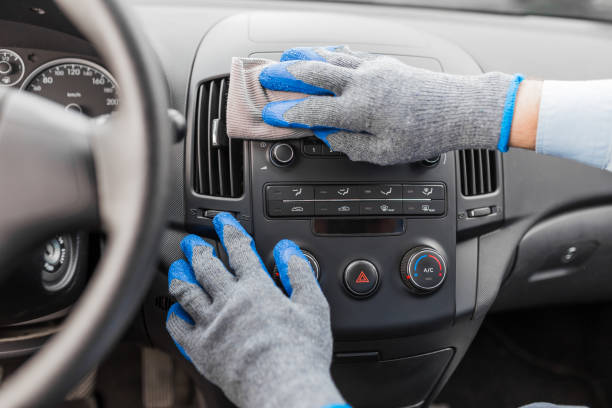Car detailing goes beyond a regular car wash to ensure that every inch of your vehicle is thoroughly cleaned, polished, and protected. Whether you’re looking to maintain your car’s appearance, preserve its value, or simply enjoy that like-new shine, detailing can provide a comprehensive deep clean. But what exactly happens during a car detailing service, and what should you expect from it?
In this article, we’ll break down the process of car detailing, including the various services offered, the benefits of each, and how to choose the right detailing package for your needs.
What Is Car Detailing?
Car detailing is a meticulous cleaning process that focuses on both the interior and exterior of the vehicle. Unlike a regular car wash, which typically just cleans the exterior, detailing involves an in-depth approach to make your car look and feel brand new. Professional detailers use specialized tools, products, and techniques to enhance the appearance of your car while also protecting its surfaces from wear and tear.
Detailing can be done as part of regular maintenance or as a way to restore the appearance of an older vehicle. Many car owners turn to detailing before selling their car to maximize resale value, or simply as a way to keep their car in pristine condition.
Types of Car Detailing Services
Car detailing services are typically divided into two main categories: exterior detailing and interior detailing. Many packages combine both for a complete deep clean. Here’s what you can expect from each:
1. Exterior Detailing
The exterior of your car faces constant exposure to environmental elements like dirt, rain, UV rays, and road debris. Over time, these factors can dull the paint, create scratches, and wear down the protective layers of your vehicle’s surface. Exterior detailing focuses on restoring and protecting your car’s outer surfaces, including the paint, wheels, and windows.
A. Washing and Drying
A basic car wash involves removing dirt and grime from the car’s exterior. However, professional detailing goes further with techniques like:
- Hand washing to avoid swirl marks that automatic brushes can leave behind.
- Clay bar treatment, which removes stubborn contaminants like tree sap, road tar, and industrial fallout that regular washing can’t eliminate.
B. Paint Polishing
After the vehicle is thoroughly washed, the next step is usually paint correction or polishing. This process helps to remove minor scratches, swirl marks, and oxidation that dull the car’s finish. Using high-quality polishers and compounds, the detailer works to restore the paint’s shine.
C. Waxing or Sealing
Once the paint is polished, a protective layer is applied. This could be:
- Waxing, which gives the car a glossy finish and adds protection against the elements.
- Paint sealants, which offer longer-lasting protection than wax and are often used for a more durable coat.
Some detailing services also offer ceramic coatings, which provide an even higher level of protection, repelling water, dirt, and UV rays for months or even years.
D. Wheel and Tire Cleaning
Wheels and tires can accumulate brake dust, road grime, and dirt that detract from the overall appearance of your vehicle. Detailing includes:
- Deep cleaning of the wheels, including inside the rims.
- Applying a tire dressing to restore the black finish and protect the rubber from cracking or fading due to exposure.
E. Glass Cleaning
The detailer will clean all exterior windows and mirrors using specialized glass cleaners that remove streaks and smudges. Some services may also include the application of a water-repellent treatment to the windshield, which improves visibility during rainy weather.
F. Trim and Chrome Polishing
Plastic and chrome trim are also cleaned and polished to restore their original luster. In some cases, trim protectants are applied to prevent fading and cracking over time.
2. Interior Detailing
The interior of your vehicle is subject to daily wear and tear from dirt, spills, and sun exposure. Interior detailing goes beyond just vacuuming the seats and carpets to thoroughly clean and protect every surface inside the car. This part of the process is just as important as exterior detailing, particularly if you spend a lot of time in your car.
A. Vacuuming
The first step in interior detailing is vacuuming all carpets, seats, floor mats, and crevices. This removes loose dirt, dust, and debris, creating a clean base for the rest of the detailing work.
B. Shampooing and Deep Cleaning
If your car has fabric seats, carpets, or mats, the detailer will typically use shampoo and a hot water extractor to remove deep stains and odors. For leather seats and trim, specialized leather cleaners and conditioners are used to prevent cracking and restore softness.
C. Steam Cleaning
Steam cleaning is another effective method used in interior detailing, especially for tough stains and to sanitize surfaces. This can be particularly helpful for removing pet hair, grime, and allergens that have settled into the fabric.
D. Interior Surface Cleaning
All surfaces inside the car, including the dashboard, console, door panels, and vents, are cleaned using appropriate products. The goal is to remove dust, fingerprints, and smudges while avoiding damage to sensitive materials.
E. Conditioning and Protecting
For leather surfaces, conditioners are applied to maintain flexibility and prevent cracking or drying. For plastic, vinyl, and rubber surfaces, protectants are used to shield against UV damage and restore a factory-fresh appearance.
F. Glass and Mirror Cleaning
All interior windows and mirrors are cleaned to remove streaks, ensuring a clear view while driving. Some services may offer anti-fog treatments for enhanced clarity in humid or cold conditions.
3. Additional Detailing Services
Beyond the standard exterior and interior detailing, many companies offer extra services for those looking for a more comprehensive treatment or specific upgrades for their vehicle. These services can include:
- Engine Bay Cleaning: This involves cleaning the engine compartment to remove dirt and grease that can build up over time. A clean engine bay not only looks better but also makes it easier to spot potential mechanical issues.
- Headlight Restoration: If your headlights have become foggy or yellowed, headlight restoration can improve both the appearance of your vehicle and your nighttime visibility.
- Odor Removal: Detailers can use ozone treatments or specialized deodorizers to eliminate stubborn smells caused by smoke, pets, or spills.
- Ceramic Coating: This advanced coating provides long-term protection against the elements, often lasting several years, with a hydrophobic (water-repellent) surface that reduces the need for frequent washing.
How Long Does a Car Detailing Service Take?
The time required for a detailing service depends on the size of your vehicle, its condition, and the level of service you select. A basic detail might take anywhere from 2 to 4 hours, while more comprehensive services could take an entire day or longer, especially if additional treatments like paint correction or ceramic coating are involved.
If you’re having both the interior and exterior detailed, it’s reasonable to expect the process to take several hours, particularly if there are issues like heavy stains, deep scratches, or excessive dirt.
The Benefits of Professional Car Detailing
Investing in a professional detailing service offers numerous benefits, including:
- Improved Appearance: Detailing restores your car’s original shine, making it look as good as new.
- Increased Resale Value: A well-maintained car holds more value, which is important if you plan to sell or trade it in.
- Protects Your Investment: Waxing, sealing, and conditioning help protect your car’s paint, interior, and surfaces from damage caused by UV rays, contaminants, and regular wear.
- Enhanced Comfort: A clean, fresh-smelling interior creates a more pleasant driving experience for both you and your passengers.
- Better Driving Visibility: Clean windows, mirrors, and headlights improve visibility and safety, especially in adverse weather conditions.
How to Choose a Car Detailing Service
When choosing a car detailing service, consider the following factors:
- Reputation: Read online reviews and ask for recommendations from friends or family.
- Service Options: Make sure the service offers the specific treatments you’re looking for, whether it’s a basic package or more advanced services like paint correction and ceramic coating.
- Experience: Look for a detailer with experience and expertise in working with different types of vehicles.
- Price: Detailing services can vary widely in cost, so it’s important to choose a package that fits your budget while offering the level of care your car needs.
Conclusion
Car detailing is a thorough process that cleans, restores, and protects your vehicle from both the inside and outside. Whether you’re looking to preserve the resale value of your car, enhance its appearance, or simply enjoy a more comfortable ride, a professional detailing service can provide the results you need. From deep-cleaning the interior to polishing and protecting the exterior, detailing offers comprehensive care that goes beyond a simple car wash.


